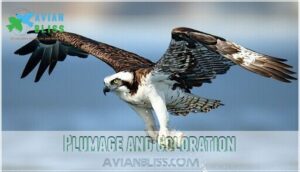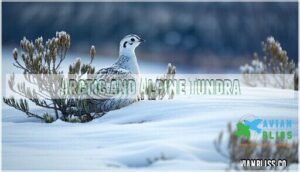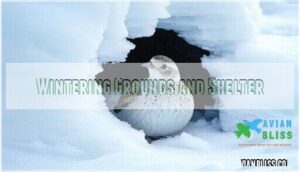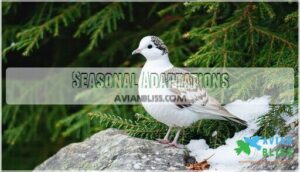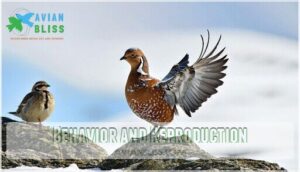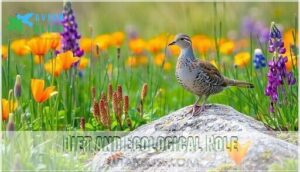This site is supported by our readers. We may earn a commission, at no cost to you, if you purchase through links.
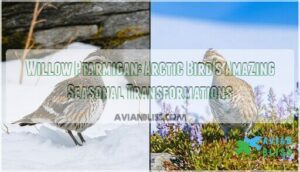
This Arctic native transforms itself with the seasons: pure white feathers for winter’s disguise, speckled brown for a summer blend.
You’ll find them scattered across the northern tundra, thriving where frost bites hardest.
They burrow into snow for warmth, switch diets as the days change, and play a key role in their ecosystem, which is pretty smart for a bird, right?
Stick around to learn how these clever shape-shifters handle life where every season brings a new test.
Table Of Contents
- Key Takeaways
- Physical Characteristics
- Habitat and Distribution
- Seasonal Adaptations
- Behavior and Reproduction
- Diet and Ecological Role
- Frequently Asked Questions (FAQs)
- Is a willow ptarmigan a grouse?
- What is a willow ptarmigan?
- Why is it called a ptarmigan?
- Are willow ptarmigan friendly?
- Are willow ptarmigan aggressive?
- Why is Alaska state bird a willow ptarmigan?
- Where do willow ptarmigans live?
- Do willow ptarmigan turn white in the winter?
- Can a willow ptarmigan fly?
- How big is a willow ptarmigan?
- Conclusion
Key Takeaways
- You’ll spot the willow ptarmigan by its feathered feet and seasonal color changes, blending into Arctic landscapes for survival.
- You’ll watch it adapt year-round, switching diets and burrowing into snow to handle the freezing tundra with smart, natural strategies.
- You’ll notice bright red eye combs on breeding males and see fierce territorial defense kick in during the mating season.
- You’ll find willow ptarmigan thriving across northern tundra, where they play a crucial role in the ecosystem as both prey and plant eaters.
Physical Characteristics
You’ll recognize a willow ptarmigan by its plump, chicken-like build that’s roughly crow-sized, measuring 14-17 inches long and weighing just over a pound.
Their most striking feature is their completely feathered feet that act like natural snowshoes, plus a distinctive red comb above their eyes and sturdy black bill designed for browsing arctic vegetation.
Body Size and Shape
When you spot a willow ptarmigan, you’ll notice it’s built like a plump chicken with a compact frame.
These hardy arctic birds measure 13.8-17.1 inches in body length and weigh 19-24 ounces, making them crow-sized but more rotund than typical songbirds.
- Size comparison: Larger than quail, smaller than teal ducks
- Weight range: Males just over one pound, females slightly less
- Bill shape: Short, stout design perfect for browsing buds
- Feather coverage: Thick plumage extends over legs and nostrils
Feathered Feet and Bill
You’ll notice the willow ptarmigan’s most remarkable winter gear – fully feathered feet that work like natural snowshoes.
These specialized toe feathers grow thick in autumn, providing essential insulation against Arctic cold while preventing them from sinking into deep snow.
Their short, stout bill perfectly complements this adaptation, designed for efficiently browsing on frozen willow buds and twigs during harsh winter months.
The willow ptarmigan’s unique physical features, including its hollow bone structure, play a vital role in its ability to thrive in extreme environments with its natural and essential adaptations.
Plumage and Coloration
You’ll notice the ptarmigan’s plumage acts like nature’s ultimate disguise kit. Their cryptic plumage changes seasonally through a complete molting process that guarantees perfect camouflage year-round.
Nature’s master of disguise, the ptarmigan transforms its plumage through the seasons for flawless camouflage against Arctic predators
This change is highly adaptable, as seen in the Color Variation by Season:
- Winter plumage – Pure white for snow camouflage
- Summer plumage – Mottled brown matching tundra
- Spring shift – Piebald brown and white patches
- Fall shift – Speckled gray, brown, and white blend
This feather structure provides incredible camouflage strategies against predators.
Distinctive Features
You’ll immediately recognize the willow ptarmigan by its bright red comb above each eye, especially prominent during breeding season.
Their feathered feet act like natural snowshoes, helping them navigate deep snow while providing essential insulation.
These feather-covered legs distinguish ptarmigan from other arctic birds, working alongside their remarkable camouflage plumage patterns for survival.
Habitat and Distribution
You’ll find willow ptarmigan across the Arctic and subarctic regions of North America, Europe, and Asia, making them one of the most widely distributed grouse species.
They migrate seasonally between high-altitude summer breeding grounds and sheltered winter valleys, often traveling hundreds of miles to find suitable habitat.
Arctic and Alpine Tundra
You’ll find willow ptarmigan thriving across the vast Arctic and Alpine Plants of the Tundra Ecosystem, where Snow Cover defines their world.
This arctic bird calls home the low shrub tundra dominated by willow and birch, from valley bottoms up to 3,000-foot mountain slopes.
Alaska wildlife enthusiasts know these tundra wildlife champions prefer open valleys between 1,000-2,500 feet elevation, where ptarmigan habitat offers the perfect blend of shelter and sustenance in the harsh Arctic Climate.
The willow ptarmigan’s adaptation to winter camouflage strategies is a key factor in their survival.
Migration Patterns and Routes
You’ll discover that willow ptarmigan undertake remarkable seasonal movements across the Arctic landscape.
These hardy birds follow predictable migration routes that showcase nature’s incredible adaptability.
Key Migration Patterns:
- Altitude Changes – Moving from high summer breeding grounds to lower winter elevations
- Seasonal Movements – Traveling hundreds of miles between tundra and forest habitats
- Habitat Shifts – Changing from open alpine areas to sheltered valley locations
- Flyway Patterns – Following established corridors across northern Canada and Alaska
- Population Dispersal – Large flocks gathering before coordinated southward journeys
Arctic bird migration represents one of nature’s most impressive survival strategies, with ptarmigan migration timing perfectly synchronized to weather patterns.
Wintering Grounds and Shelter
You’ll discover willow ptarmigan create ingenious snow burrows for winter survival, burrowing deep into drifts that provide essential feather insulation against arctic cold.
These birds seek sheltered valleys where wind protection combines with their specialized cold adaptations.
Winter roosts become snow-covered sanctuaries where tundra habitat transforms into protective igloos, allowing arctic wildlife to endure harsh conditions through strategic shelter selection.
The willow ptarmigan’s ability to adapt to their environment is influenced by their bird habitat preferences, which play a vital role in their survival.
Geographic Range and Population
Willow ptarmigan span circumpolar arctic regions across Alaska, Canada, Scandinavia, and Siberia.
You’ll find over 15 million birds globally, with Alaska hosting more than one million.
These tundra birds experience population cycles every 3-10 years due to predation and weather.
Canada holds 30% of North America’s ptarmigan species, while conservation status remains stable despite occasional habitat loss affecting migration routes.
Seasonal Adaptations
You’ll witness one of nature’s most remarkable transformations as the willow ptarmigan changes from snow-white winter plumage to mottled brown summer feathers.
This annual makeover helps them survive Arctic conditions by matching their surroundings perfectly while adapting their behavior and diet to each season’s challenges, which is a crucial aspect of their survival.
Winter Plumage and Camouflage
You’ll witness nature’s most impressive disappearing act when winter arrives.
White plumage transforms willow ptarmigan into living snowballs, achieving near-perfect arctic concealment through cryptic coloration.
These winter feathers aren’t just about camouflage strategies—they’re survival tools.
Snow adaptation includes UV-reflective properties that fool even sharp-eyed predators, while dense plumage provides essential insulation against subzero temperatures.
The willow ptarmigan’s ability to survive harsh winters relies on effective body temperature regulation mechanisms to conserve heat and energy.
Summer Plumage and Molting
As warm weather arrives, you’ll witness the ptarmigan’s remarkable transformation through its molting process.
Nature’s master of disguise sheds winter white for summer browns in a stunning seasonal makeover.
The lagopus lagopus sheds its white winter coat for mottled brown and gray summer plumage, perfectly matching tundra surroundings.
This feather replacement occurs gradually, creating a piebald appearance during spring.
The color change provides essential summer camouflage, helping ptarmigan species blend seamlessly with rocks, vegetation, and shadows while foraging.
Snow Burrowing and Insulation
Beyond their remarkable plumage changes, willow ptarmigan have mastered Arctic survival through ingenious snow shelter techniques.
Masters of the Arctic, willow ptarmigan turn deep snow into cozy sanctuaries, weathering the cold with incredible ingenuity
You’ll find these birds creating burrows that serve as natural insulation systems during harsh winters.
Their snow burrow behavior includes:
- Diving headfirst into snowbanks to avoid leaving tracks
- Spending most winter days underground for warmth
- Using feathered feet as natural snowshoes for movement
- Choosing powder snow locations for ideal insulation
This cold adaptation strategy rivals snowy owls for winter survival effectiveness.
The willow ptarmigan’s ability to create effective snow shelter systems is vital for their survival in the Arctic environment with ingenious snow shelter techniques and natural insulation systems.
Feeding Habits and Diet Changes
Dietary flexibility defines the willow ptarmigan’s survival strategy across harsh seasonal changes.
You’ll discover these birds shift from summer’s protein-rich insects and berries to winter’s woody buds and twigs.
Their foraging strategies adapt completely – summer feeding focuses on ground-level food sources while winter diet relies heavily on elevated willow branches for essential nutrient intake, showcasing their ability to thrive through seasonal changes.
Behavior and Reproduction
You’ll witness fascinating breeding behaviors when ptarmigan establish their spring territories and begin courtship rituals.
Males perform elaborate displays with tail fanning and foot drumming to attract females, while pairs often remain together for months to successfully raise their young, exhibiting strong courtship rituals.
Mating and Courtship Displays
Once you understand their amazing seasonal adaptations, you’ll witness willow ptarmigan’s elaborate courtship rituals during spring breeding season.
Males perform spectacular displays to attract females and defend their territories.
Willow Ptarmigan Courtship Behaviors:
- Territorial Defense – Males aggressively guard 3-20 acre territories through vocalizations and physical confrontations
- Red Comb Display – Breeding males develop distinctive bright red eye-combs that females use for mate selection
- Courtship Rituals – Males perform tail fanning, wing spreading, bowing, parading, and foot drumming displays
- Monogamous Behavior – Most pairs form exclusive bonds, staying together for up to 7 months
- Breeding Strategies – While typically monogamous, 5-9% of males practice polygamous breeding with multiple hens
Nesting and Incubation Behavior
Female willow ptarmigan select nest sites in shallow ground depressions, often hidden beneath willow shrubs or grasses.
You’ll find their egg laying occurs in late May through June, with clutches averaging 6-10 eggs.
The incubation period lasts 21-22 days, with females solely responsible for warming eggs while males guard nearby territories during this critical brood care phase, which involves complete concepts of nesting and incubation.
Parental Care and Chick Development
After hatching, willow ptarmigan chicks develop remarkably quickly under their parents’ watchful care.
You’ll find both male and female ptarmigan species sharing brood care duties, with the parental bond lasting about sixty days.
During the fledgling stage, chick growth accelerates as parents guide them to food sources.
This exceptional parental care guarantees ptarmigan behavior includes strong family units through challenging Arctic conditions.
Social Structure and Territoriality
During breeding season, male willow ptarmigan establish territories ranging from three to twenty acres, arriving weeks before females.
You’ll observe intense territorial behavior as males defend boundaries through vocal challenges and physical confrontations.
Dominance patterns emerge through courtship displays, with successful mate selection depending on territory size and social hierarchy within ptarmigan behavior dynamics.
The willow ptarmigan’s unique territorial call sounds play a vital role in establishing and maintaining these territories.
Diet and Ecological Role
You’ll find the willow ptarmigan’s diet changes dramatically with the seasons, shifting from nutrient-rich berries and insects in summer to woody twigs and buds during harsh Arctic winters.
This remarkable bird plays a vital role in tundra ecosystems, serving as both herbivore and prey species that connects plant communities to predator networks, and is a key part of the tundra ecosystems.
Summer Foraging and Food Sources
During summer months, you’ll find willow ptarmigan transformed into versatile foragers, capitalizing on the tundra’s brief abundance.
Their diet shifts dramatically from winter’s woody fare to nutrient-rich seasonal offerings.
- Berry Selection: They target crowberries, blueberries, and cranberries for essential sugars
- Seed Foraging: Ptarmigan facts reveal they collect seeds from grasses and sedges
- Insect Hunting: Alaska birds catch protein-rich caterpillars and beetles for chicks
- Leaf Eating: Tundra birds consume tender willow and birch leaves throughout summer
Understanding willow ptarmigan food sources online is vital for their conservation.
Winter Diet and Nutrition
Winter brings dramatic dietary shifts for willow ptarmigan as they switch from summer’s varied menu to specialized winter foraging.
You’ll find these Arctic birds feeding almost exclusively on twigs and buds from birch and willow trees during harsh months.
Their nutrient intake relies heavily on catkin consumption, which provides essential fats and proteins.
This birch diet sustains ptarmigan facts through freezing temperatures when other food sources disappear beneath snow.
Feeding Habits and Foraging Strategies
You’ll notice willow ptarmigan use deliberate, energy-efficient foraging tactics throughout their harsh Arctic habitats.
These birds employ careful feeding behavior, methodically browsing for food sources while conserving precious energy.
Their summer diet includes berries and insects, while winter brings diet variations focused on woody plants.
Smart nutrient acquisition strategies help them survive extreme conditions, adapting their feeding habits seasonally.
Understanding their diet requires knowledge of bird feeding habits to appreciate the complexity of their foraging strategies, using energy-efficient methods.
Ecological Importance and Conservation Status
Beyond their foraging behaviors, willow ptarmigan serve as keystone species in Arctic wildlife conservation.
These birds maintain Ecosystem Balance through their impact on tundra habitat vegetation and predator-prey relationships.
However, Climate Impact threatens their survival:
- Habitat Preservation efforts focus on protecting undisturbed tundra areas
- Species Decline occurs in peripheral populations due to environmental stress
- Conservation Efforts monitor hunting statistics and citizen science data
- Wildlife conservation depends on maintaining healthy shrub communities
Effective Arctic conservation requires understanding bird conservation methods.
Frequently Asked Questions (FAQs)
Is a willow ptarmigan a grouse?
One day you’re slogging through brush, next you’re spotting a willow ptarmigan—yes, it’s a grouse.
Think of it as the Arctic’s answer to chickens, tough as nails, thriving where few birds dare wander.
What is a willow ptarmigan?
You’ll spot this chubby bird strutting across Arctic tundra, sporting feathered boots and a knack for camouflage.
It changes color with the seasons, eats buds and berries, and braves bitter winters by burrowing into snowy shelters.
Why is it called a ptarmigan?
You call it a ptarmigan because the word comes from the Scottish Gaelic “tarmachan,” meaning “croaker.”
That name fits, since this bird’s low, throaty calls echo across the tundra—a sound as wild as the north itself.
Are willow ptarmigan friendly?
By sheer coincidence, you’ll find that most ptarmigan aren’t exactly keen for a cuddle.
They prefer keeping to themselves, using camouflage and quick dashes to avoid humans.
You’re more likely to glimpse them than greet them.
Are willow ptarmigan aggressive?
You won’t find these birds picking fights for no reason, but during breeding season, they’ll fiercely defend their territory and mates.
It’s like flipping a switch—suddenly, the usually chill ptarmigan turns into a determined guardian, and this change is quite notable as they become fierce defenders of their territory.
Why is Alaska state bird a willow ptarmigan?
Freedom on the winds—Alaska’s state bird is a willow ptarmigan because it’s tough, masters camouflage, and survives brutal winters.
You’ll see it thrive where few others can, echoing Alaska’s wild, resilient spirit and adaptability.
Where do willow ptarmigans live?
These birds spend their summers roaming the Arctic tundra, from Alaska to Norway, but when winter blows in, they tuck into forests or valleys for shelter.
You’ll spot them where snow’s deep, and food’s within reach.
Do willow ptarmigan turn white in the winter?
In winter, you’ll spot them decked out in brilliant white, blending right into the snow.
This clever color change helps them dodge hungry predators—nature’s way of handing them an invisible cloak when survival is on the line, utilizing nature’s innate mechanisms.
Can a willow ptarmigan fly?
You might spot one bursting from the tundra, wings whirring fast—yes, it can fly!
While it prefers walking or running, the willow ptarmigan will take to the air quickly if startled, dodging predators with surprise spurts.
How big is a willow ptarmigan?
Picture a football rolling through snowdrifts— that’s about the size of it.
You’re looking at a stocky bird, 15–17 inches long, weighing just over a pound.
Its wingspan stretches roughly two feet, perfect for brisk surprises.
Conclusion
Watch the willow ptarmigan adapt, thrive, and inspire in its Arctic home.
You see its color change, diet shift, and clever survival tactics at play.
Each season, the willow ptarmigan blends, hides, and endures, offering insight into nature’s precision and resilience.
You learn how this bird shapes its environment and responds to challenges, proving even a small bird makes a big impact.
Now you’ve got a bird worth remembering whenever winter’s chill returns.

